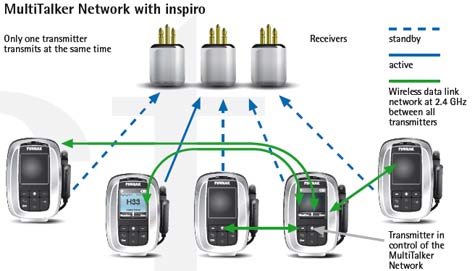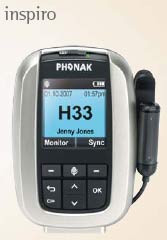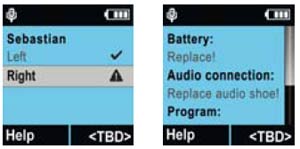Interview with Pat Henry, Managing Director Wireless and Pediatrics Phonak
Share:
Paul Dybala: Hello, everyone. This is Dr. Paul Dybala with Audiology Online, and today I am speaking with Pat Henry from Phonak. Pat welcome, and thanks for coming onto the web site to talk to me today. Pat Henry: Thank you Paul, I'm very privileged to again get to join you and share new wireless pr
Paul Dybala: Hello, everyone. This is Dr. Paul Dybala with Audiology Online, and today I am speaking with Pat Henry from Phonak. Pat welcome, and thanks for coming onto the web site to talk to me today.
Pat Henry: Thank you Paul, I'm very privileged to again get to join you and share new wireless product information.
Dybala: Pat and I have been talking about doing this interview for a while. He kept telling me, "Paul, we've got some really special wireless technology that we are coming out with" and we are finally getting together and it was definitely worth the wait.
Phonak really has a groundbreaking series of features they have added to their FM systems. But before I let the cat out of the bag, Pat, could you tell our readers just a little bit about who you are and what you do for Phonak?
Henry: Sure. I manage the wireless and pediatric businesses for Phonak. I have been with Phonak for about eight years, and I have been in the industry for over 25 years managing some other companies as well.
Dybala: The new FM system Phonak has recently released in the US is called inspiro, and so I wanted to sit down with Pat and go over some of the features. Pat, could you briefly give us a general overview of where Phonak found inspiration for inspiro?

Henry: One of the bigger breakthroughs that Phonak wireless technology had in 2003 was automatic and direct frequency synchronization, which is currently in our traditional FM systems, What we wanted to do now was improve the performance of our current traditional wireless technologies by improving the FM functionality of the FM signal, develop a new monitoring system and provide a FM system that is both adaptive and automatic.
We have developed a transmitter that can monitor the ambient noise in the classroom and also monitor the students' receivers." We also have a new type of MultiTalker Network incorporated in as well. There are actually seven strong features that we added to this technology: Dynamic Speech Extractor, AutoConnect, ChannelFinder, DataLogging FM, MultiTalker Network, Monitoring, and SoundCheck, but today I wanted to talk about the three primary ones. They are, Dynamic Speech Extractor, MultiTalker Network, and Monitoring.
Dybala: Sounds great, let's talk about Dynamic Speech Extractor.
Henry: Sure. Within this feature we have now an Adaptive FM advantage, which adjusts the FM gain depending on the environmental noise level. Additional gain is added if the background noise level increases. So the big thing is that in traditional FM we had a fixed FM level, which was +10 dB. So now what we do is actually have the transmitter monitoring the ambient noise level; we can estimate the ambient noise levels in the speech pauses.
If the ambient noise level rises to over 57 dB, a command is sent from the transmitter to the dynamic FM receivers to increase the FM advantage. The command is a digital code sent with the FM signal at a different inaudible audio frequency, but then if the noise level drops again, the FM advantage will also reduce itself as well.
Dybala: So, if the ambient noise level is 57 dB or less, you have the + 10 dB FM advantage. Then as it rises, how much does that increase by? What is the maximum amount that you are able to achieve?
Henry: We are able to increase it another 14 dB, so we have up to a 24 dB FM Advantage. This translates into the miraculous thing that the signal to noise ratio at ear level has become independent of the ambient noise level between 57 and 73 dB ambient noise level. And this is for all types and brands of hearing instruments that are FM compatible.
Dybala: Wow, I could see where, especially if you are in a very noisy environment, you would need that.
Henry: Absolutely.
Dybala: Now, I also know that you have done some research to validate some of this. Could you tell us a little bit about that?
Henry: Sure. We asked Dr. Linda Thibodeau from the Callier Center in Dallas to help us with this. She had 10 subjects, ages 11 to 59 years, with moderate to profound hearing losses. Nine of the 10 were experienced FM users. After one week of usage, they put the subjects into four different listening situations with FM, and they didn't know which was traditional FM and which was the dynamic FM.
We did the HINT test for word recognition. We had different noise levels, starting at 54 dB going up to 80 dB. The primary goal was to see the advantage of dynamic FM over traditional FM. Remember that threshold of ambient noise is 57 dB when it starts to adjust the FM level.
The results were that on the 63 dB dynamic level, we saw a 10% increase in percentage words correct over traditional FM. At 68 dB, we saw a 25% increase, and at 73 dB, we saw over a 50% improvement over traditional FM.
Dybala: Did the subjective comments from the users reflect what you found in the speech-in-noise tests?
Henry: Yes. They were very favorable in quiet situations and then in noisy situations, where we really want to maintain that FM advantage over the environmental microphone, the dynamic FM really did well. Additionally, 10 out of the 10 people preferred dynamic FM over traditional FM in the classroom situation as well.
Dybala: Tell me about the MultiTalker Network.
Henry: Sure. Today, we have what we call team-teaching systems, and the primary benefit of these is when you have two speakers, or teachers, in the classroom. There are many times in a classroom environment where teachers are doing pod teaching, so students will go from one station to another station. With the current team-teaching FM system, we can facilitate two teachers transmitting at the same time.
We decided that we need to improve the current team-teaching system, however. With the current system, both microphones are open at the same time and both transmitters are open at the same time. So the student is receiving communication, or speech, simultaneously, and has to mix that speech and then decipher it. When there are pauses and one of the teachers is not speaking, the student still hears the open microphone.
So, we developed what we call MultiTalker Network, which is a system that allows up to 10 speakers in the network. They all transmit at the same channel, which can be the standard classroom channel, but they do not talk at the same time. At any moment in time, only one of the transmitters in the network is allowed to transmit. Channel access is organized by priority rules. You have a priority transmitter, called the initiator transmitter that basically is the primary transmitter in this multi-talker network.
We utilize a 2.4 gigahertz frequency to communicate between all transmitters in the MultiTalker Network. The initiator continuously gathers information regarding the kind of signals present at each FM microphone, and opens accordingly the right transmitter.
There are, of course, some manners that need to be practiced when people are talking, but you have the priority transmitter, or the initiator, and then the other transmitters can be open when the initiator is not talking. Does that make sense?
Dybala: Yes. The system will listen as other speakers begin to talk and switch the appropriate microphones off and on. It's all automatic, correct?
Henry: Exactly. All automatic. And the other benefit is that you have only one microphone open, so the other microphones are not transmitting any background noise or any side discussions or things like that. Only the transmitter that is open is the one actually transmitting speech.

MultiTalker Network, taken from Phonak inspiro technical booklet
Dybala: Sure, that makes sense. You don't want the noise of other teachers working with another child, writing something on the board, or even just shuffling papers. That could all be coming through, affecting the signal-to-noise ratio.
Henry: It's also an application that we see in the adult population as well, because there are many times where surgeons want to use multi-talker networks, and there's many times attorneys want to use multi-talker networks. We think this feature will be utilized in other segments besides school and pediatrics.
Dybala: I agree, I could use this feature on some of the conference calls I am on sometimes. [laughter] Well, let's talk about the third feature with the inspiro, Monitoring. Obviously, this is one of those key things because, if the FM system isn't working, then it really doesn't matter what these other features are. [laughs]
Henry: [laughs] Exactly! Well, we know at Phonak that our FM systems are vital for education, and we know that a daily system check by the teachers makes sure the system is working properly. In some systems, we've had LEDs that were not really reliable, because the hearing instrument could be in no-FM program and the LED would still light up. So we wanted to come up with a totally new concept, taking the FM system check to a whole new level.

So, what we have done with this new inspiro transmitter is create the capability for a wireless check by FM receivers, controlled by the teachers. You just push a button. It sends out a command, roughly about an arm's length away, and then the receivers talk back to the inspiro. What happens is you get a green light for "okay" or a red light for "not okay."
If it's a red light, it will tell you to replace the battery if it needs to be replaced. It will tell you to replace the audio shoe if you're using an audio shoe which does not have good contacts. It will tell you what the receiver settings are, what the FM gain, or the FM advantage is. It will also tell you the user name and the serial number.
So, if it's red, that means you're going to get these useful tips in the display. If it's green, you're going to get a verbal beep that will tell you that the system is right, because we know that visual information isn't the only way to do it. You need to be complemented by different auditory cues as well.

Monitoring display on the Inspiro
Dybala: That sounds like a really great feature. I'm just thinking about older FM systems: you could do a listening check, and you couldn't hear anything coming through. I remember having to switch out components, piece by piece, to try and determine which piece was failing. Here, you've got a screen readout that tells you exactly what steps to take in order to fix the problem.
Henry: Exactly.
Dybala: Humans tend to be lazy, [laughs] with anything in general. What you're doing here, which is great, is reinforcing a way to make it easy to actually accomplish the critical component of that daily listening check, to make sure everything's working.
Henry: Absolutely. The other thing that we've done is made it possible to monitor the receiver through the transmitter; however, we also have the transmitter monitoring itself. So the inspiro transmitter performs a self-check at startup. It checks all the buttons, if they're working correctly. It checks the battery. It checks the charge circuit. It checks the audio input connection.
It also continuously checks to see if the microphone is muted. So, if the microphone is muted for more than 15 minutes, or you get a low battery, we have a vibra-alarm on the transmitter that tells you either the microphone is muted or you need to charge your battery. And you get a message in the display that will notify the user.
Dybala: So, if they miss the warning, they've got some serious problems, I guess, [laughs] is another way of saying that.
Henry: Exactly!
Dybala: Well, this is great. We've been talking about the new inspiro FM system today. This is really just the tip of the iceberg, and I do want to direct everyone to where you can find additional information. I would encourage you to do this because of everything else that Phonak has done with this system this we didn't talk about today. If you go to www.phonak.com, you can find a wide range of resources there.
They've got the www.eschooldesk.com web site that you can access, www.fmelibrary.com, and www.fmcounselware.com. They've got all their literature online, as far as the papers that they publish.
I really would encourage you to get more information. Also, I'm sure you can call up Phonak and ask for Pat Henry, and he'd be more than happy to talk to you about that. Finally, you could look at Audiology Online's Web Channel for Phonak at www.audiologyonline.com/channels/phonak.asp, where we're always posting new information about Phonak.
So, with that, I'll go ahead and close out the interview and say, Pat, thanks again for taking time to speak with me today. We look forward to talking to you in the future.
Henry: Thanks, Paul. We appreciate getting to share this exciting technology.

Phonak - Life is on
We are sensitive to the needs of everyone who depends on our knowledge, ideas, and care. And by creatively challenging the limits of technology, we develop innovations that help people hear, understand, and experience more of life's rich soundscapes.
Interact freely, Communicate with confidence. Live without limit. Life is on.
About Phonak
Headquartered near Zurich, Switzerland, Phonak has developed, produced and globally distributed state-of-the-art hearing systems and wireless devices for over 50 years. The combination of expertise in hearing technology, mastery in acoustics and strong cooperation with hearing care professionals allows Phonak to significantly improve people's hearing ability and speech understanding and therefore their quality of life.
Phonak offers a complete range of digital hearing instruments, along with complementary wireless communication systems. With over 4000 employees worldwide, Phonak drives innovation and sets new industry benchmarks regarding miniaturization and performance.
Pat Henry: Thank you Paul, I'm very privileged to again get to join you and share new wireless product information.
Dybala: Pat and I have been talking about doing this interview for a while. He kept telling me, "Paul, we've got some really special wireless technology that we are coming out with" and we are finally getting together and it was definitely worth the wait.
Phonak really has a groundbreaking series of features they have added to their FM systems. But before I let the cat out of the bag, Pat, could you tell our readers just a little bit about who you are and what you do for Phonak?
Henry: Sure. I manage the wireless and pediatric businesses for Phonak. I have been with Phonak for about eight years, and I have been in the industry for over 25 years managing some other companies as well.
Dybala: The new FM system Phonak has recently released in the US is called inspiro, and so I wanted to sit down with Pat and go over some of the features. Pat, could you briefly give us a general overview of where Phonak found inspiration for inspiro?

Henry: One of the bigger breakthroughs that Phonak wireless technology had in 2003 was automatic and direct frequency synchronization, which is currently in our traditional FM systems, What we wanted to do now was improve the performance of our current traditional wireless technologies by improving the FM functionality of the FM signal, develop a new monitoring system and provide a FM system that is both adaptive and automatic.
We have developed a transmitter that can monitor the ambient noise in the classroom and also monitor the students' receivers." We also have a new type of MultiTalker Network incorporated in as well. There are actually seven strong features that we added to this technology: Dynamic Speech Extractor, AutoConnect, ChannelFinder, DataLogging FM, MultiTalker Network, Monitoring, and SoundCheck, but today I wanted to talk about the three primary ones. They are, Dynamic Speech Extractor, MultiTalker Network, and Monitoring.
Dybala: Sounds great, let's talk about Dynamic Speech Extractor.
Henry: Sure. Within this feature we have now an Adaptive FM advantage, which adjusts the FM gain depending on the environmental noise level. Additional gain is added if the background noise level increases. So the big thing is that in traditional FM we had a fixed FM level, which was +10 dB. So now what we do is actually have the transmitter monitoring the ambient noise level; we can estimate the ambient noise levels in the speech pauses.
If the ambient noise level rises to over 57 dB, a command is sent from the transmitter to the dynamic FM receivers to increase the FM advantage. The command is a digital code sent with the FM signal at a different inaudible audio frequency, but then if the noise level drops again, the FM advantage will also reduce itself as well.
Dybala: So, if the ambient noise level is 57 dB or less, you have the + 10 dB FM advantage. Then as it rises, how much does that increase by? What is the maximum amount that you are able to achieve?
Henry: We are able to increase it another 14 dB, so we have up to a 24 dB FM Advantage. This translates into the miraculous thing that the signal to noise ratio at ear level has become independent of the ambient noise level between 57 and 73 dB ambient noise level. And this is for all types and brands of hearing instruments that are FM compatible.
Dybala: Wow, I could see where, especially if you are in a very noisy environment, you would need that.
Henry: Absolutely.
Dybala: Now, I also know that you have done some research to validate some of this. Could you tell us a little bit about that?
Henry: Sure. We asked Dr. Linda Thibodeau from the Callier Center in Dallas to help us with this. She had 10 subjects, ages 11 to 59 years, with moderate to profound hearing losses. Nine of the 10 were experienced FM users. After one week of usage, they put the subjects into four different listening situations with FM, and they didn't know which was traditional FM and which was the dynamic FM.
We did the HINT test for word recognition. We had different noise levels, starting at 54 dB going up to 80 dB. The primary goal was to see the advantage of dynamic FM over traditional FM. Remember that threshold of ambient noise is 57 dB when it starts to adjust the FM level.
The results were that on the 63 dB dynamic level, we saw a 10% increase in percentage words correct over traditional FM. At 68 dB, we saw a 25% increase, and at 73 dB, we saw over a 50% improvement over traditional FM.
Dybala: Did the subjective comments from the users reflect what you found in the speech-in-noise tests?
Henry: Yes. They were very favorable in quiet situations and then in noisy situations, where we really want to maintain that FM advantage over the environmental microphone, the dynamic FM really did well. Additionally, 10 out of the 10 people preferred dynamic FM over traditional FM in the classroom situation as well.
Dybala: Tell me about the MultiTalker Network.
Henry: Sure. Today, we have what we call team-teaching systems, and the primary benefit of these is when you have two speakers, or teachers, in the classroom. There are many times in a classroom environment where teachers are doing pod teaching, so students will go from one station to another station. With the current team-teaching FM system, we can facilitate two teachers transmitting at the same time.
We decided that we need to improve the current team-teaching system, however. With the current system, both microphones are open at the same time and both transmitters are open at the same time. So the student is receiving communication, or speech, simultaneously, and has to mix that speech and then decipher it. When there are pauses and one of the teachers is not speaking, the student still hears the open microphone.
So, we developed what we call MultiTalker Network, which is a system that allows up to 10 speakers in the network. They all transmit at the same channel, which can be the standard classroom channel, but they do not talk at the same time. At any moment in time, only one of the transmitters in the network is allowed to transmit. Channel access is organized by priority rules. You have a priority transmitter, called the initiator transmitter that basically is the primary transmitter in this multi-talker network.
We utilize a 2.4 gigahertz frequency to communicate between all transmitters in the MultiTalker Network. The initiator continuously gathers information regarding the kind of signals present at each FM microphone, and opens accordingly the right transmitter.
There are, of course, some manners that need to be practiced when people are talking, but you have the priority transmitter, or the initiator, and then the other transmitters can be open when the initiator is not talking. Does that make sense?
Dybala: Yes. The system will listen as other speakers begin to talk and switch the appropriate microphones off and on. It's all automatic, correct?
Henry: Exactly. All automatic. And the other benefit is that you have only one microphone open, so the other microphones are not transmitting any background noise or any side discussions or things like that. Only the transmitter that is open is the one actually transmitting speech.

MultiTalker Network, taken from Phonak inspiro technical booklet
Dybala: Sure, that makes sense. You don't want the noise of other teachers working with another child, writing something on the board, or even just shuffling papers. That could all be coming through, affecting the signal-to-noise ratio.
Henry: It's also an application that we see in the adult population as well, because there are many times where surgeons want to use multi-talker networks, and there's many times attorneys want to use multi-talker networks. We think this feature will be utilized in other segments besides school and pediatrics.
Dybala: I agree, I could use this feature on some of the conference calls I am on sometimes. [laughter] Well, let's talk about the third feature with the inspiro, Monitoring. Obviously, this is one of those key things because, if the FM system isn't working, then it really doesn't matter what these other features are. [laughs]
Henry: [laughs] Exactly! Well, we know at Phonak that our FM systems are vital for education, and we know that a daily system check by the teachers makes sure the system is working properly. In some systems, we've had LEDs that were not really reliable, because the hearing instrument could be in no-FM program and the LED would still light up. So we wanted to come up with a totally new concept, taking the FM system check to a whole new level.

So, what we have done with this new inspiro transmitter is create the capability for a wireless check by FM receivers, controlled by the teachers. You just push a button. It sends out a command, roughly about an arm's length away, and then the receivers talk back to the inspiro. What happens is you get a green light for "okay" or a red light for "not okay."
If it's a red light, it will tell you to replace the battery if it needs to be replaced. It will tell you to replace the audio shoe if you're using an audio shoe which does not have good contacts. It will tell you what the receiver settings are, what the FM gain, or the FM advantage is. It will also tell you the user name and the serial number.
So, if it's red, that means you're going to get these useful tips in the display. If it's green, you're going to get a verbal beep that will tell you that the system is right, because we know that visual information isn't the only way to do it. You need to be complemented by different auditory cues as well.

Monitoring display on the Inspiro
Dybala: That sounds like a really great feature. I'm just thinking about older FM systems: you could do a listening check, and you couldn't hear anything coming through. I remember having to switch out components, piece by piece, to try and determine which piece was failing. Here, you've got a screen readout that tells you exactly what steps to take in order to fix the problem.
Henry: Exactly.
Dybala: Humans tend to be lazy, [laughs] with anything in general. What you're doing here, which is great, is reinforcing a way to make it easy to actually accomplish the critical component of that daily listening check, to make sure everything's working.
Henry: Absolutely. The other thing that we've done is made it possible to monitor the receiver through the transmitter; however, we also have the transmitter monitoring itself. So the inspiro transmitter performs a self-check at startup. It checks all the buttons, if they're working correctly. It checks the battery. It checks the charge circuit. It checks the audio input connection.
It also continuously checks to see if the microphone is muted. So, if the microphone is muted for more than 15 minutes, or you get a low battery, we have a vibra-alarm on the transmitter that tells you either the microphone is muted or you need to charge your battery. And you get a message in the display that will notify the user.
Dybala: So, if they miss the warning, they've got some serious problems, I guess, [laughs] is another way of saying that.
Henry: Exactly!
Dybala: Well, this is great. We've been talking about the new inspiro FM system today. This is really just the tip of the iceberg, and I do want to direct everyone to where you can find additional information. I would encourage you to do this because of everything else that Phonak has done with this system this we didn't talk about today. If you go to www.phonak.com, you can find a wide range of resources there.
They've got the www.eschooldesk.com web site that you can access, www.fmelibrary.com, and www.fmcounselware.com. They've got all their literature online, as far as the papers that they publish.
I really would encourage you to get more information. Also, I'm sure you can call up Phonak and ask for Pat Henry, and he'd be more than happy to talk to you about that. Finally, you could look at Audiology Online's Web Channel for Phonak at www.audiologyonline.com/channels/phonak.asp, where we're always posting new information about Phonak.
So, with that, I'll go ahead and close out the interview and say, Pat, thanks again for taking time to speak with me today. We look forward to talking to you in the future.
Henry: Thanks, Paul. We appreciate getting to share this exciting technology.

Phonak - Life is on
We are sensitive to the needs of everyone who depends on our knowledge, ideas, and care. And by creatively challenging the limits of technology, we develop innovations that help people hear, understand, and experience more of life's rich soundscapes.
Interact freely, Communicate with confidence. Live without limit. Life is on.
About Phonak
Headquartered near Zurich, Switzerland, Phonak has developed, produced and globally distributed state-of-the-art hearing systems and wireless devices for over 50 years. The combination of expertise in hearing technology, mastery in acoustics and strong cooperation with hearing care professionals allows Phonak to significantly improve people's hearing ability and speech understanding and therefore their quality of life.
Phonak offers a complete range of digital hearing instruments, along with complementary wireless communication systems. With over 4000 employees worldwide, Phonak drives innovation and sets new industry benchmarks regarding miniaturization and performance.